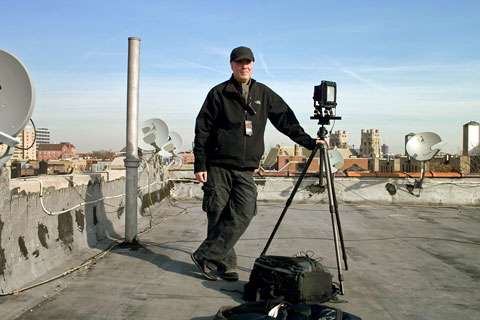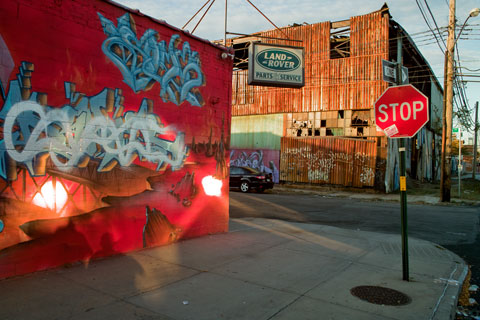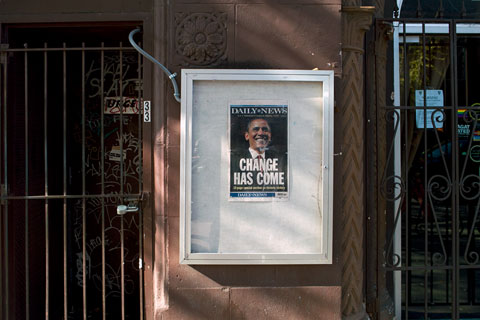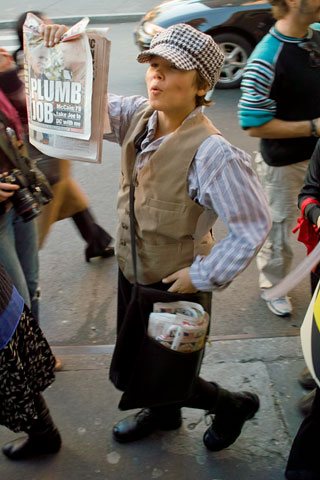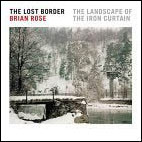Saturday, November 29, 2008
Monday, November 24, 2008
Thursday, November 20, 2008
New York/Yankee Stadium

Yankee Stadium under construction (digital)
© Brian Rose
Went up to the Bronx to scout a building for an upcoming photo shoot. The 4 train goes up by Yankee Stadium, and I got out and did a couple of snapshots of the nearly completed new stadium. The old edifice still stands across the street, but it will soon be dis-Mantled and de-Ruthed.
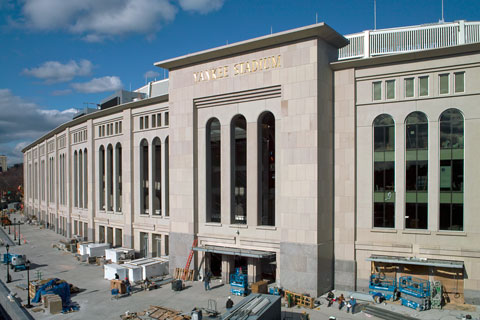
Yankee Stadium under construction (digital)
© Brian Rose
I'm not sure about retaining the neoclassical facade of the original stadium, though I don't think a techie steel and glass approach would make sense here in the Bronx. What I do like is that the stadium will, like the old one, remain a building on the street hugging the elevated subway. Not a stadium machine, like so many others. Glimpses of the field will still be possible from the windows of the passing trains, and a replica of the famous frieze will wrap around the upper deck. My understanding is that it is essentially a modern stadium inserted into the envelope of a more traditional exterior.
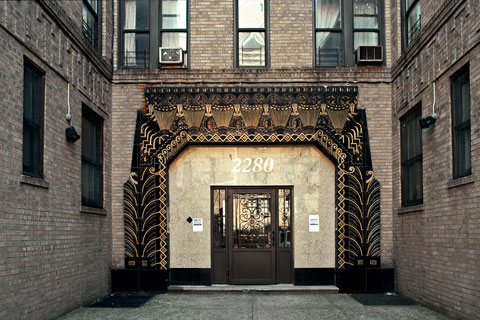
Bronx apartment building entrance. (digital)
© Brian Rose
The new stadium, designed by HOK Sport echoes the design of the original ballpark, but it has a more monumental feel, cleaner, but with deeper cut arches. Although it doesn't reflect Art Deco, the dominant Bronx style, it does remind me of other monumental buildings of that era, like 30th Street station in Philadelphia, which manages to incorporate both classicism and deco design. My guess is that it will wear well here on 161st Street. Fans will gather on the plaza as before, and the nearby bars and souvenir shops will flourish as always. And the ghosts of Mantle and Ruth will hover a while in confusion, but eventually decide that new stadium is nicer, and has better restrooms, among other amenities.
Saturday, November 15, 2008
New York/Astor Place
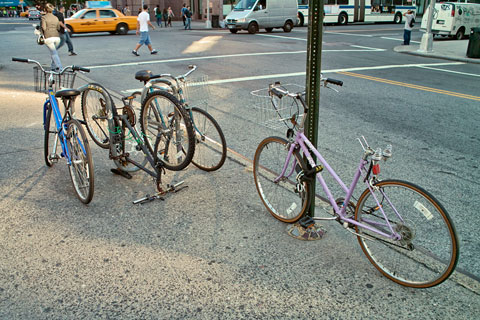
Astor Place (digital)
© Brian Rose
The photograph above shows how bikes tend to be parked in New York. Usually, the only option is a signpost or light pole. Every now and then, one finds the repeating U shape rack as seen to the left. Not always with three bikes, one of them upside down.
Having lived in Amsterdam for 12 years--while traveling back and forth to New York--and married to a Dutch urban planner, I feel I can comment with some level of authority on the issue of bike racks. The Netherlands, as is well known, is among the most bicycle-oriented places in the world, but even there, they continue to struggle with the problem of parking and storing thousands and thousands of bikes on the city streets.
The Dutch attach their bikes to anything sturdy including light poles, signposts, bridge railings, fences, you name it. Bike racks, too. A quick image search on bike racks in Amsterdam produces dozens of different designs, mostly incredibly complicated and impractical. Despite the apparent riot of different designs, the official bike rack for central Amsterdam is a simple bent piece of metal shaped like a staple. There are no photographs of them on the Internet, presumably because they are so uninteresting. Unobtrusive is a virtue in my opinion.
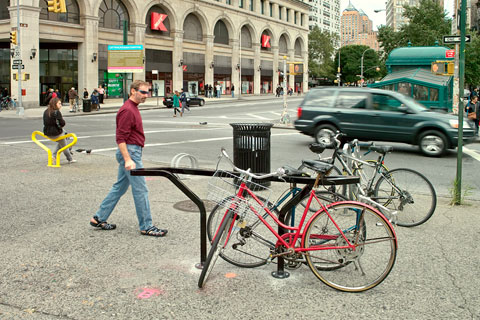
Astor Place (digital)
© Brian Rose
The Bloomberg administration has actively promoted bicycle use in New York City, creating bike lanes, and in some cases, segregated bike paths along major avenues. The city has just completed a design competition for what will become the standard bike rack used throughout the five boroughs. Prototypes of the 10 finalists were mounted on the traffic island in Astor Place--the one with Alamo, the famous black cube sculpture by Tony Rosenthal.
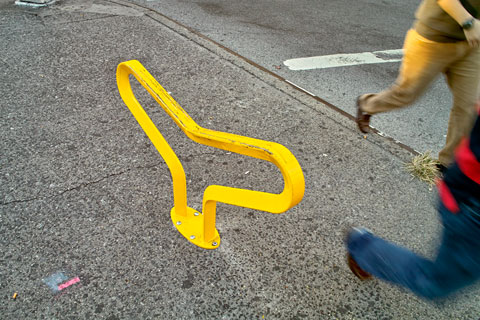
Astor Place (digital)
© Brian Rose
Good for sitting on.
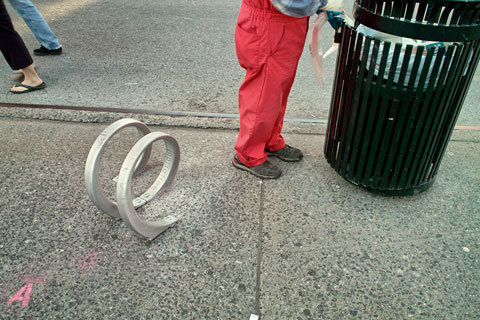
Astor Place (digital)
© Brian Rose
Good for tripping over.
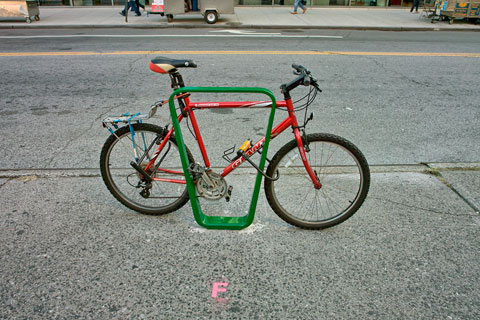
Astor Place (digital)
© Brian Rose
Not bad.
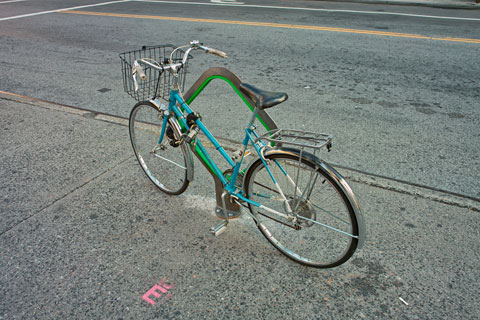
Astor Place (digital)
© Brian Rose
Looks good with this bike.

Astor Place (digital)
© Brian Rose
Almost.
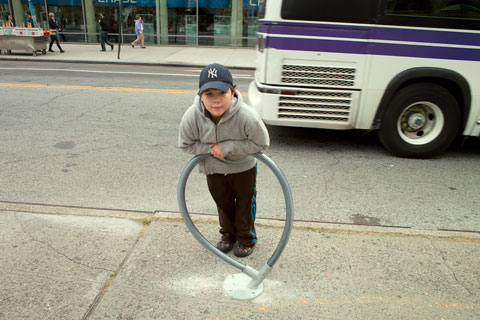
Astor Place (digital)
© Brian Rose
Brendan, my son, leaning on the wittiest of the bunch, modeled after a steel cable bicycle lock.
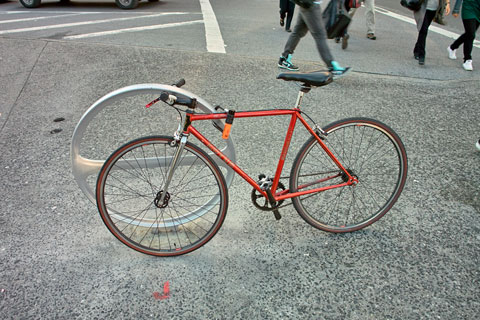
Astor Place (digital)
© Brian Rose
The winning design, "Hoop," by Ian Mahaffy and Maarten De Greeve, based in Copenhagen. It's one of the simplest of the designs, can be used singly or in groups, parrallel to the curb when the sidewalk is narrow, and perpendicular when there is more space. Those commenting to the article on the New York Times website are all concerned about how it can be securely attached to the pavement. I think the round shape gives people the impression that it just grazes the surface of the sidewalk. But imagine a steel post beneath the wheel at the point where it touches the ground. It should be at least as sturdy as the traffic signposts already used by most cyclists.
It's elegant, flexible, iconic. I like it.
Thursday, November 13, 2008
Tuesday, November 11, 2008
Saturday, November 08, 2008
New York/Joel Sternfeld
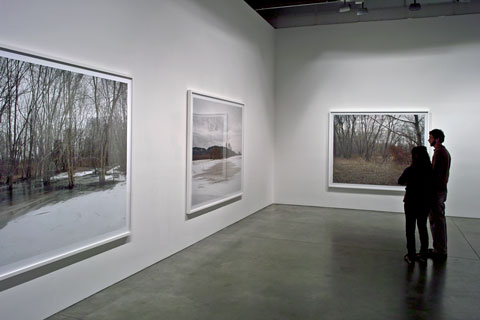
Joel Sternfeld exhibition at Luhring Augustine, New York (digital)
© Brian Rose
A month ago I took in Joel Sternfeld’s exhibit at Luhring Augustine in Chelsea. The work shown—the Oxbow Archive—is a series of pictures of a square mile of farm, field, and woodland, along the Connecticut River, made over a year’s time, ordered by date. The full set of 77 photographs is available in a book of the same name.
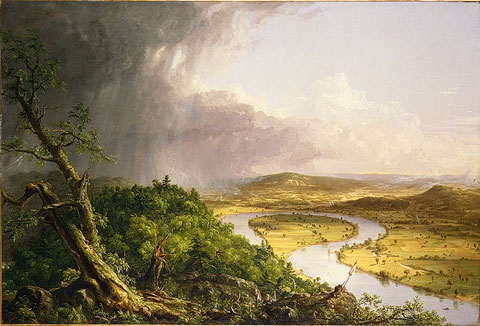
View from Mount Holyoke, Northampton, Massachusetts,
after a Thunderstorm—The Oxbow, 1836, Thomas Cole,
The Metropolitan Museum of Art
The landscape depicted in Sternfeld's series was famously painted by Thomas Cole in 1836 in all the idealized grandeur of the Hudson River School. Sternfeld, rather than mount the nearby heights like Cole, stays close to the muddy ground.
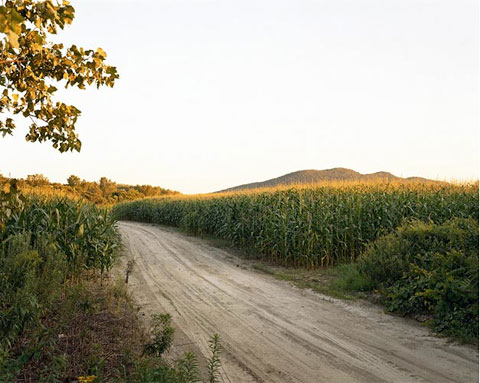
August_19_2006 • Joel Sternfeld • The Oxbow Archive
It is a landscape held, for the moment, in a cautious equilibrium. Tractors leave their imprints in the soft soil among the swaying cornfields. Weeds and puddles of water luxuriate beneath changing skies, as often dull and clouded as sunny and radiant. The fields alternate between cultivated and fallow.
As in Sternfeld’s earlier pictures of the High Line in New York City, the persistence of nature springs forth everywhere despite the taming influence of the plow and other man made incursions. The smallest gestures of tangled growth are carefully described by the view camera—even celebrated. Visual events are carefully, but gently, noted in passing: a flock of sleeping geese in a field, a curled up raccoon (dead or alive?), an abandoned campfire, a toppled tree, clumps of withered cornstalks in a field.
There is no text in the book, though there is a gallery press release that emphasizes the political and social critique offered by Sternfeld's work, especially in relation to his earlier visual essays on American utopian communities and global warming. These new images fit within the continuity of Sternfeld's work going back to the more acerbic and ironic pictures of American Prospects. But there is something about these images that resonates on a different level--something personal or spiritual--expressing the culmination (at this stage) of a long career of looking and thinking deeply about the world we live in.

Mohonk Mountain House • New Paltz, New York (digital)
© Brian Rose
Recently, I traveled with my family up the Hudson River to the Mohonk Mountain House with its fairy tale hotel nestled in the mountains near New Paltz. And I thought about Sternfeld's photographs as I hiked around and climbed Sky Top for the views of the surrounding countryside. The resort dates back to the 19th century and its siting in the landscape arrayed with rustic pavilions and rocky pathways embodies the romantic concept of nature expressed by Thomas Cole and his compatriots. Some of the same ideas can be found in Olmsted and Vaux's great urban parks and private gardens. Nature majestic, yet tamed by man--if not by actually constructing upon the land, then by framing it, aestheticizing it.
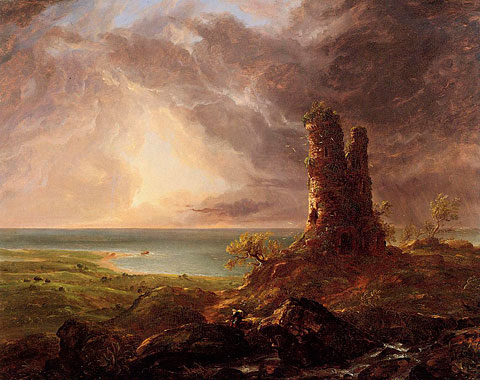
Romantic Landscape with Ruined Tower, Thomas Cole, 1832-36
Albany Institute of History and Art
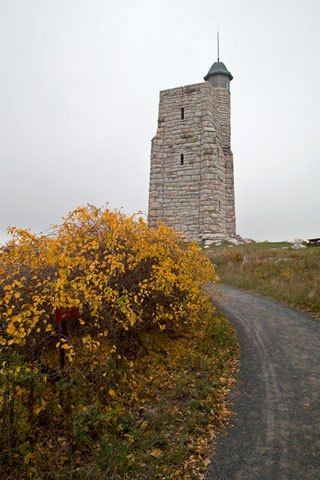
Smiley Memorial Tower, Mohonk Mountain House (digital)
© Brian Rose
Rustic tower on the promontory of Sky Top overlooking the surrounding Hudson River valley and Shawangunk Mountains.
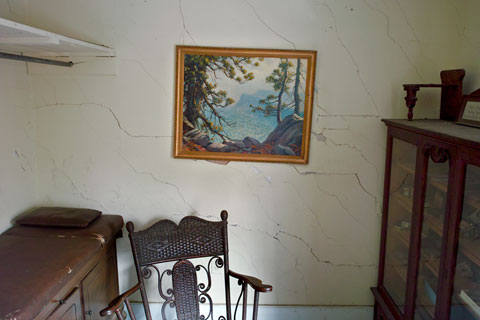
The Barn Museum at the Mohonk Mountain House (digital)
© Brian Rose
Mountains framed by rocks and trees. Nature sublime, but ordered.
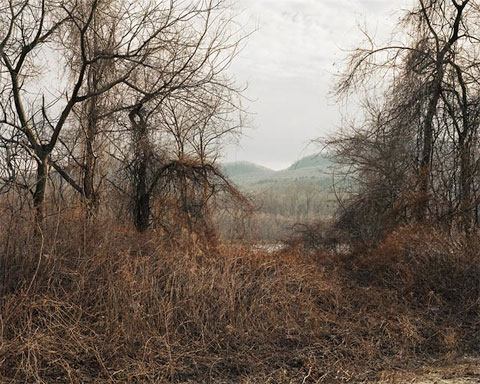
November 29, 2006 • Joel Sternfeld • The Oxbow Archive
For many years photographers embraced the notion of framing the landscape for heroic or picturesque affect. But it has been a long time since serious photographers have taken that approach. Sternfeld doesn't bring a wholly new way of seeing to the task of photographing the Oxbow. He builds his visual case methodically, image by image, day by day, season by season. He treads the same ground over and over, follows the same paths repeatedly, revisits familiar fields, ponds, glades, the same briar patches. Systematic becomes meditative and vice versa. What emerges eventually is a comprehensive experience of time and space.
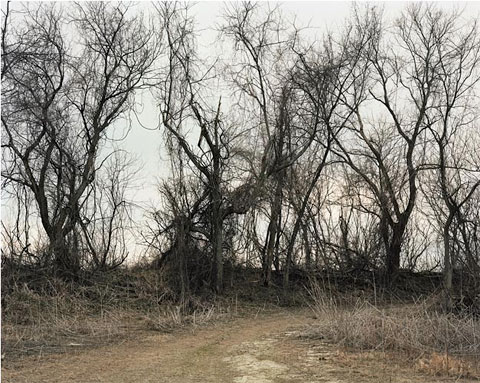
March 13, 2006 • Joel Sternfeld • The Oxbow Archive
When I first looked at Sternfeld's Oxbow images, their stillness seemed absolute. But out of that silence I began to hear sounds off camera--the crunch of the photographers boots on crusted snow, the snap and crack of twigs and branches, the silibance of wind through leaves. And then, the growl of a distant tractor, the drone of an approaching plane, the white noise of nearby Interstate 91. I began to sense the encroaching proximity of civilization in these unpeopled images.
When I greeted Joel Sternfeld at the exhibit opening back in September I told him that these were, perhaps, his most beautiful photographs. His response was that he felt that he was born to do this work. Whatever the presumed message of this project, environmental or political, I see the Oxbow Archive, ultimately, as a search for an ineffable nexus--a muddy path leading into an unknowable and uncertain future.
New York/Rockefeller Center
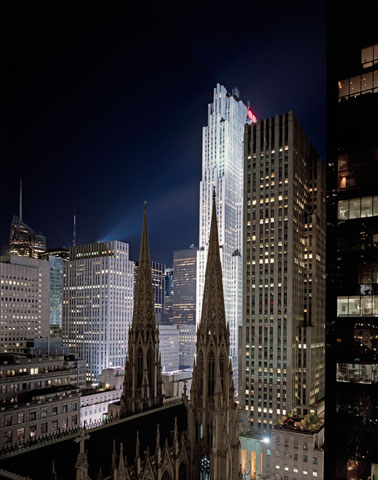
Rockefeller Center and St. Patrick's Cathedral (4x5 film)
© Brian Rose
The architectural photography I do tends often to be corporate interiors, very often in Midtown Manhattan. Most of the time I shoot after hours when the office workers have gone home. If possible I get a couple of shots just before sundown, when the light turns blue, and the inside and outside are relatively balanced. But after that, the windows go black and reflect the brightly lit florescent interior. The city outside almost disappears.
Recently, I was shooting in a 1960s wedding cake building at 51st and Madison, so called because of the multiple setbacks required at that time by zoning regulations. There were doors from some of the offices leading out to a narrow terrace formed by the stepping of the facade. From the terrace I saw a stunning view of Rockefeller Center seen across the spires of St. Patrick's Cathedral. Near the end of the shoot--1am or so--I took my view camera out on the terrace and did the image above. Two minute exposure, little wind.


